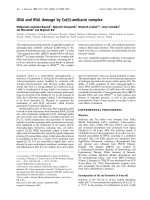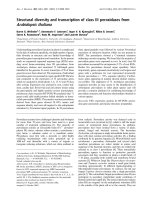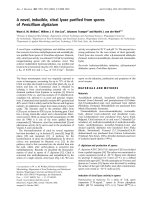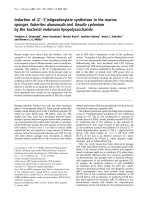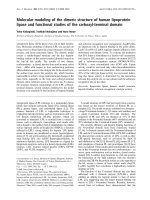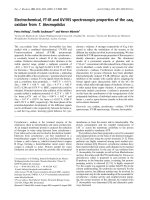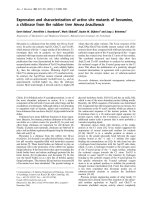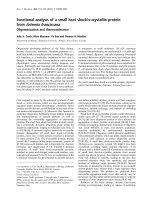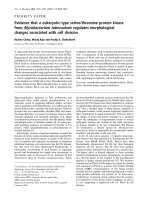Báo cáo y học: "Microbicides 2006 conference" docx
Bạn đang xem bản rút gọn của tài liệu. Xem và tải ngay bản đầy đủ của tài liệu tại đây (286.34 KB, 10 trang )
BioMed Central
Page 1 of 10
(page number not for citation purposes)
AIDS Research and Therapy
Open Access
Short report
Microbicides 2006 conference
Gita Ramjee*
1
, Robin Shattock
2
, Sinead Delany
3
, Ian McGowan
4
,
Neetha Morar
1
and Megan Gottemoeller
5
Address:
1
HIV Prevention Research Unit, Medical Research Council, Durban, South Africa,
2
Centre for Infection, Cellular and Molecular Medicine,
St. George's University of London, London, UK,
3
Reproductive Health and HIV Research Unit, University of Witwatersrand, Johannesburg, South
Africa,
4
UCLA AIDS Institute, University of California, Los Angeles, USA and
5
Global Campaign for Microbicides, Washington, DC, USA
Email: Gita Ramjee* - ; Robin Shattock - ; Sinead Delany - ;
Ian McGowan - ; Neetha Morar - ; Megan Gottemoeller -
* Corresponding author
Abstract
Current HIV/AIDS statistics show that women account for almost 60% of HIV infections in Sub-
Saharan Africa. HIV prevention tools such as male and female condoms, abstinence and monogamy
are not always feasible options for women due to various socio-economic and cultural factors.
Microbicides are products designed to be inserted in the vagina or rectum prior to sex to prevent
HIV acquisition.
The biannual Microbicides conference took place in Cape Town, South Africa from 23–26 April
2006. The conference was held for the first time on the African continent, the region worst affected
by the HIV/AIDS pandemic. The conference brought together a record number of 1,300 scientists,
researchers, policy makers, healthcare workers, communities and advocates. The conference
provided an opportunity for an update on microbicide research and development as well as
discussions around key issues such as ethics, acceptability, access and community involvement.
This report discusses the current status of microbicide research and development, encompassing
basic and clinical science, social and behavioural science, and community mobilisation and advocacy
activities.
Background
It has been twenty five years since HIV/AIDS was first rec-
ognized, with disproportionate number of infections
among women. Sub-Saharan Africa houses the largest
number of HIV infected women. It is thus not surprising
that women are now the focus of HIV prevention efforts.
Microbicides are products designed to be women initiated
which could have the potential to prevent HIV infection,
should she not be able to negotiate condom use with her
partner. The products can be formulated as gels, creams
and suppositories, and could be inserted in the vagina
prior to sex. It is hoped that these products would have a
bidirectional effect; prevent male to female and female to
male transmission of HIV. In addition, the products are
also being tested for safety during rectal use.
Recently, microbicides have attracted a lot of attention in
the media, with commitments for accelerated research
coming from philanthropic and public sectors. The bian-
nual Microbicides conference was held earlier this year in
Cape Town, South Africa. The conference attended by
more than 1,300 delegates was held for the first time on
Published: 13 October 2006
AIDS Research and Therapy 2006, 3:25 doi:10.1186/1742-6405-3-25
Received: 06 September 2006
Accepted: 13 October 2006
This article is available from: />© 2006 Ramjee et al; licensee BioMed Central Ltd.
This is an Open Access article distributed under the terms of the Creative Commons Attribution License ( />),
which permits unrestricted use, distribution, and reproduction in any medium, provided the original work is properly cited.
AIDS Research and Therapy 2006, 3:25 />Page 2 of 10
(page number not for citation purposes)
the African continent. In this issue, we report on some of
the key messages emanating from this very important con-
ference. The conference agenda covered recent develop-
ments in basic, clinical and social science, and for the first
time in the history of the conference, included a commu-
nity track. This track covered community partnerships and
involvement, donor panels and general discussions on
microbicide advocacy.
The outcomes of each track are summarised below.
Track A: Basic Science
Robin Shattock
The basic Science track (Track A) reviewed the current sta-
tus of microbicide design and development. In her ple-
nary presentation, Prof Sharon Hillier (University of
Pittsburg, USA) demonstrated the microbicide discovery
pipeline which has a broad diversity of compounds acting
at different stages in the viral lifecycle, each exhibiting sig-
nificant strengths and challenges for development. In
reviewing different classes of product such as surfactants,
acid buffers, polyanians, etc, we are seeing an increasing
push for drugs with higher potency. First generation prod-
ucts (including membrane disrupting compounds, non-
specific fusion inhibitors and acid buffering agents), while
having broad activity against a range of sexually transmit-
ted diseases, are limited by the requirement for coitally
dependent use with moderate or lower potency against
HIV. Recent research has focussed on the push for drugs
with increasing potency which has only been achievable
through the targeting of specific components of the viral
life cycle (attachment, fusion and reverse transcription),
often at the expense of activity against other sexually
transmitted diseases. This means that products with high
anti-HIV potency are not likely to act against sexually
transmitted pathogens such as Chlamydia and Gonorrhoea.
The richest pipeline of new compounds entering clinical
development is the use of antiretroviral drugs (ARVs) in
new formulations. These drugs have high specificity and
potency. The use of ARVs could for the first time give rise
to the development of some degree of coitally independ-
ent microbicides delivered either as a daily application, or
through sustained delivery devises such as intravaginal
rings currently used for contraception. The potential
downside of such products is the lack of efficacy against
other sexually transmitted infections (STIs) and the
potential for resistance evolution.
A plenary by Professor Mark Wainberg's (AIDS Centre,
Montreal, Canada) discussed the issues and implications
surrounding the use of ARVs in microbicides. While resist-
ance to individual ARV-containing microbicides is possi-
ble if used by women unaware of their HIV positive status,
the limited systemic absorption of such products would
reduce likelihood of such evolution. However, a more
pressing concern regarding resistance, could be the trans-
mission of the virus that is resistant to the compounds
contained in the microbicide formulation. Nevertheless, it
is likely that the use of combination ARVs would be the
next logical step to prevent resistance evolution, analo-
gous to current treatment regimes. Given some of the
challenges, the development of an effective product is
likely to be a long process. Ultimately an effective micro-
bicide would most likely be a combination product, pro-
viding protection against HIV-1 and other STDs and
possibly combined with different barriers such as vaginal
diaphragms for example, or delivery technologies such as
vaginal rings – a true hybrid product.
One of the most important corner stones of microbicide
development in addition to efficacy is safety and certainly
no microbicide candidate should disrupt natural barriers
to infection. Work presented in Track A demonstrated sig-
nificant progress in identifying potential biomarkers of
safety in preclinical cellular, tissue and animal models.
Betsy Harold (Mount Sinai Hospital, New York, USA) pre-
sented a novel murine model using sub-lethal challenge
with HSV infection that could provide a functional assay
to assess candidate safety [1]. Riana Fichorova (Harvard
Medical School, USA) and Gustavo Doncel (CONRAD
Eastern Virginia Medical School, USA) presented data on
a range of inflammatory cytokines and epithelial expres-
sion of Cyclooxygenase, as markers of vaginal inflamma-
tion that could provide a matrix of parameters to predict
in vivo safety [2,3]. The delicate nature of innate barriers
to infection was elegantly demonstrated by Cecilia Cheng-
Mayer (Aaron Diamond AIDS Research Center, USA)
studying the effects of depoprovera on susceptibility of
rhesus macaques to diverse viral strains. Depoprovera,
which reduces the natural barrier provided by cervicovag-
inal epithelium, rendered animals more susceptible to a
wider diversity of viral strains and lead to dominance of
HIV-1 X4 viral replication [4].
Leonid Margolis (NICHD, Bethesda, USA) discussed how
the selective transmission of HIV-1 R5 viruses suggested
that there are a number of natural gatekeepers which
selectively block mucosal transmission of HIV-1 X4
strains. These multiple gatekeepers pointed to the impor-
tance of blocking HIV-1 transmission at more than one
level, providing a strong rationale for a combination
approach to effective microbicide development as men-
tioned by Professors Hillier and Wainberg. Giving exam-
ples of natural pathogens that negatively impact on HIV
replication (including Measles, HHV6 and 7), Margolis
suggested they could unlock potential strategies for induc-
ing protective innate responses [5].
This theme was taken up by Dr Maddy Hayes (St George's
University of London, UK) who demonstrated that innate
AIDS Research and Therapy 2006, 3:25 />Page 3 of 10
(page number not for citation purposes)
resistance to HIV infection could be induced in mucosal
explants by immuno-modulatory oligonucleotides. The
future focus of this work is to define the mechanisms of
innate resistance and find ways to boost this in vivo. How-
ever, defining the mechanism of innate resistance to HIV
in humans and its modulation by microbicides is perhaps
someway from being realized. The current products have
been actively evaluated for resistance evolution in cellular
and animal models [6].
One of the more promising approaches is the targeting of
the cellular co-receptor CCR5 utilized by the majority of
transmitted strains. Two candidates in this category dem-
onstrated high levels of protection in macaque challenge
models [7,8]. Furthermore, work presented by John
Moore demonstrated that combination of entry inhibitors
could further enhance the levels of protection provided by
blockade or CCR5 alone [7]. Drs Donald Mosier and Eric
Arts (Case Western Reserve University) suggested that
PSC-RANTES had a high barrier for resistance, most likely
related to its ability to cause sequestration of the inhibitor
within target cells [9]. In contrast work by Dr Qinxue Hu
(St George's University of London, UK) demonstrated that
resistance to Cyanovirin, that targets the virus through
binding to gp120, could evolve with only three muta-
tions, but the in vivo significance was unclear [10]. Fur-
thermore, the activity of a wide range of antiviral plant
lectins (including cyanovirin), presented by Dr Yven Van
Herrewegewith (Institute of tropical Medicine, Belgium),
may allow the development of combinations that further
restrict the potential for resistance evolution [11].
The Basic science track also covered the issue of microbi-
cide formulation leading to the development of microbi-
cide products appropriate to wide-scale use. Professor
David Woolfson (Queens University Belfast) presented
the current state of the art for microbicide formulations
and drug delivery. Appropriate formulation is seen to be
essential to make a usable product in terms of efficacy and
acceptability. Microbicides can be delivered through a
variety of drug delivery devises, gel, creams, tablets, pessa-
ries and controlled release devises such as intravaginal
rings. Each technology has different strength and weak-
ness. While current trials are focussed on the use of gels
applied with every act of intercourse, newer technologies
are being pursued that will allow products to be applied
on a daily of weekly basis. Perhaps the most promising
new technology is the development of microbicide release
from intravaginal ring (IVRs), already used for hormonal
contraception. Recent data from David Woolfson's group
suggests that these rings could release preventive levels of
antiretroviral drugs (ARVs) for greater than six months.
While such technology is best adapted to delivery of small
hydrophobic drugs, recent modifications suggest that they
could be adapted to release a wider range of compounds,
including peptide or protein based microbicides. A
number of additional approaches are under development,
including novel vaginal delivery systems which are trig-
gered on contact with semen allowing drug release only
following ejaculation (Patrick Kisser, University of Utah,
USA) [12].
The Basic Science track demonstrated that there are a wide
range of microbicide candidates at different stages of
development, providing a broad width of strategies to pre-
vent mucosal HIV transmission. The future development
of the field is likely to focus on development of agents
with increasing potency and the use of sustained delivery
technology to provide prolonged protection.
Track B: Clinical Science
Sinead Delany-Moretlwe
The clinical track reviewed microbicides and other tech-
nologies such as the vaginal diaphragm in the prevention
of HIV. Results of safety studies together with an update of
current Phase III trials were presented.
Phase I/II Safety trials
A long term safety study of praneem (a polyherbal vaginal
tablet), when compared with placebo gel, was shown to
be safe and acceptable in a study conducted in 100 HIV
negative, monogamous women. 56% of women experi-
enced an adverse event, but the majority of these (79%)
were considered mild. Only 0.7% experienced severe
adverse events. Most of the adverse events were associated
with genital discomfort. Other adverse events observed
included nausea associated with the smell of the product,
intermenstrual bleeding and dysuria. There was no differ-
ence in the frequency or severity of adverse events
observed between women in the praneem and placebo
groups. Given the safety profile of praneem, it was recom-
mended that this product be advanced to phase III trials
[13].
A 14-day randomized, controlled safety and acceptability
trial of Acidform™ compared with KY Jelly demonstrated
that Acidform™ is more likely to cause genital irritation
than KY Jelly (OR 2.6, p = 0.009). Although more peeling
was observed on colposcopy in the Acidform™ group
(25% vs. 4%), there appeared to be a decrease in pro-
inflammatory cytokines observed in Acidform users. The
study confirmed Acidform's potential to maintain the
acidic environment of the vagina, with statistically signif-
icant differences in pH observed between the two groups.
However, the changes to the vaginal flora were minimal.
A greater proportion of women in the Acidform™ group
found the gel unpleasant or neutral [14].
A randomized controlled trial of 0.5% PRO 2000 demon-
strated that compared with placebo, this product is non-
AIDS Research and Therapy 2006, 3:25 />Page 4 of 10
(page number not for citation purposes)
inflammatory after 14 days of application in a group of
low risk women. A similar rate of adverse events was
observed in both groups (70%). The most frequent symp-
tom was genital burning. No increase in pro-inflamma-
tory cytokines was observed in the PRO 2000 group. A
trend toward increased anti-HSV activity was observed at
day 7, but the clinical significance of this could not be
determined at this stage [15].
A 3-arm phase I safety study examined the effect Carra-
guard compared with placebo or no gel, on cell-free HIV
in the genital secretions of 40 HIV infected women. The
results showed that Carraguard does not influence HIV
shedding in the genital tract; no change in levels of HIV
was observed in this group. As expected, levels of HIV in
the genital tract correlated strongly with levels of HIV in
the plasma [16].
A pre-phase I study to characterize the rectal mucosal
safety parameters showed that studies involving regular
sigmoidscopy and biopsy are feasible to conduct; and that
cytokine and T cell measurements are useful markers of
safety. These markers were not influenced by sexual prac-
tice. This suggests that it will be possible to identify mean-
ingful endpoints for Phase 1 RM safety studies [17].
Two studies examining the safety of lime juice as a poten-
tial microbicide concluded that lime Juice did not appear
to be safe in concentrations of ≥ 50%, the concentration
required to inactivate HIV in semen [18].
Barrier methods
Several trials demonstrated that physical barriers when
used in combinations with gels were safe, acceptable and
in some cases effective as contraceptives.
A 14-day randomized, controlled trial examined the safety
of a silicone diaphragm when used in combination with
either Buffergel, Acidform or KY Jelly (as placebo) in 81
low risk women. Adverse events were generally mild. 45
women reported experiencing adverse events; 26 of which
were possibly related to study product. However, no seri-
ous adverse events were observed. The most frequent
adverse events reported included backache, and genital
discomfort. Severe findings on colposcopy were observed
in two participants, both of whom were in the Acidform
group. Colposcopic findings were generally more fre-
quent in the two gel arms. The authors recommended that
both these combinations be evaluated in Phase III trials
[19].
Another randomized controlled trial evaluated the safety
of the Ortho All flex diaphragm when used with 6% Cel-
lulose Sulfate (CS) or with KY Jelly (placebo gel) com-
pared with CS gel use alone over 6 months in South
African women. Very few of the participants in this study
had ever used diaphragms before. This combination was
found to be safe with no serious adverse events or adverse
events related to diaphragm use reported. Colposcopic
findings were observed in 60–80% of participants. Seven
severe findings were observed in those using CS in combi-
nation with the diaphragm. However, these differences
were not statistically significant. The location of these
findings on the external genitalia suggest that they may
have been due to trauma following diaphragm insertion.
The authors recommended advancing these combinations
to phase III trials [20].
Buffergel in combination with a diaphragm was shown to
be as effective as contraceptive as a spermicide used in
combination with a diaphragm in a randomized, control-
led non-inferiority trial. The point estimate pregnancy rate
for Buffergel was 10.1 after 6 months of use. Buffer gel was
not inferior to Gynol II, a currently available spermicide.
In addition, urinary tract infection rates were lower in the
Buffergel group. Side effect rates were similar in both
groups, and were usually related to mild genital irritation;
only 3% of participants felt that adverse events were a rea-
son to discontinue the gel. The combination of Buffergel
and diaphragm was acceptable to participants with 66%
reporting that they would use this method in the future
[21].
Buffergel Duet is a new device which appears to be both
safe and acceptable and has potential as an over the coun-
ter product. A non-comparative study conducted in the
USA among 30 couples who used the product twice per
week over a period of one week, showed that 83%
inserted the device correctly the first time after receiving
written instructions only. The most common adverse
events reported were abdominal pain. Colposcopic find-
ings included external genital abrasions which were
thought to be due to product insertion. 75% of couples
were satisfied with the device with most reporting that this
device was better or the same as the diaphragm [22].
Phase III trials update, April 2006
A number of products have already advance to Phase III
trials. Table 1 summarises those products, the location
and progress of the Phase III trials. The first results of effec-
tiveness trials are expected in 2007. There are a number of
challenges facing the conduct of these trials including
lower than expected rates of HIV incidence leading to the
closure of at least one trial site. Adherence to gel was also
identified as a challenge particularly in the context of no
gel use, and high incidence of pregnancy among trial par-
ticipants.
AIDS Research and Therapy 2006, 3:25 />Page 5 of 10
(page number not for citation purposes)
Future trial designs
A plenary talk by Benôit Mâsse discussed issues around
future designs of microbicide trials, should an efficacious
product be identified among the current generation of
microbicide trials. With a number of "first generation"
products in Phase III trials, consideration needs to be
given to the design of future microbicide trials if one or
more of these products is shown to be at least partially
effective. When deciding whether to use placebo controls
or active controls, it will be necessary to consider the rela-
tive effectiveness of the product, the safety profile of the
two products to be compared and the populations in
which these products have been tested. It may still be
acceptable to use placebo controls in untested popula-
tions if there is uncertainty about any of these parameters.
An alternative to superiority trials are non-inferiority tri-
als. However, non-inferiority trials may prove more chal-
lenging, and may not even be feasible to implement
because of the requirement for large sample sizes. In cases
where the comparison gel is of known low effectiveness
(30–40%), superiority trials may still be preferable. Add-
on trials are also an option for evaluating a combination
of proven products with the addition of a new product in
the active arm. However, they are limited in their ability
to assess monotherapy. All of these options need to be
considered within the context of a strong ethical frame-
work, where acceptability to communities is also taken
into account.
Rectal Microbicides
Ian McGowan
Anal intercourse (AI) remains the most important risk fac-
tor for HIV-1 transmission and super infection among
men having sex with men (MSM) and heterosexual anal
intercourse. A growing body of epidemiological studies
suggests that AI may be a relatively common practice
among heterosexuals. It is clear that a safe and effective
rectal microbicide will be important for both MSM and
heterosexuals who practice AI.
Dr. Ian McGowan presented an overview of how rectal
microbicide safety will be assessed in clinical trials. Micro-
bicides have been evaluated in a number of animal model
systems including mice and non-human primates. Epithe-
lial damage is the main criterion for toxicity but Zeitlin et
al. have documented increased vulnerability to infections
such as herpes simplex 2 (HSV-2) as another index of
microbicide toxicity [23]. Human intestinal explants pro-
vide a useful ex vivo/in vitro means to assess microbicide
toxicity. Assessment of cytotoxicity can be performed on
the basis of histology or the MTT [3-(4,5-dimethylthiazol-
2-yl)-2,5-diphenyltetrazolium bromide] assay. Abner and
Fletcher have both recently published detailed descrip-
tions of this approach to toxicity assessment [24,25].
Human rectal safety studies are extremely limited but
have demonstrated that nonoxynol-9 is not safe in the rec-
tal compartment [26-28]. Epithelial disruption may be a
relatively crude index of microbicide toxicity. It is conceiv-
able that products may induce immunological changes
(increased cell activation, cell recruitment, upregulation
of HIV-1 co-receptors) that increase the risk of HIV trans-
mission but are not apparent using standard histological
techniques.
Dr. Peter Anton reviewed methodological challenges in
designing human rectal safety studies. While the field has
much to gain from experience acquired in vaginal micro-
bicide clinical trials and design, there have been no Phase
1/Investigational New Drug (IND) rectal microbicide tri-
als to date. The first such study is planned to start in the
3
rd
quarter of 2006 and will evaluate the rectal safety of the
vaginal formulation of UC-781. In his talk, Dr Anton
Table 1: Update of Phase IIB/III clinical trials, April 2006
Network Products Design Population Endpoints Progress to date
Population Council Carraguard Placebo Ph III RCT 3 sites 6639 16–40 years HIV 6000 accrued
HIV Prevention Trials Network
(HPTN 035)
BufferGel PRO 2000 0.5%
Placebo Condom only
Ph II/IIb safety and
effectiveness RCT
5 sites; 800 (Ph II); Safety; HIV 827 accrued
CONRAD CS 6% Placebo Ph III RCT 4 sites 2574 HR women HIV CT, GC 738 accrued
Microbicides Development
Programme (MDP)
PRO 2000 0.5% PRO
2000 2% Placebo
Ph III RCT 5 sites 9673 HIV HSV, GC 640 accrued
Family Health International (FHI) CS 6% Placebo Ph III RCT 2 sites 2160 HR women HIV CT, GC 1102 accrued
Methods for Improving Reproductive
Health in Africa (MIRA)
All flex diaphragm with
Replens Condom only
Open-label RCT 5000 HIV HSV2 CT, GC,
TV Acceptability
Completed accrual;
Family Health International (FHI) C31G 1% Placebo Ph III RCT 4284 HR women HIV Ghana closed Feb-06
2100 accrued
Nigeria
Source: Trial Updates and Preliminary Data of Phase IIb/III Microbicide Trials. Guest Speaker Session. Microbicides 2006 Conference, Cape Town,
South Africa, 23–26 April 2006.
CT: Chlamydia tracomatis
GC: N. gonorrhoea
TV: Trichomonas vaginalis
CS: Cellulose sulphate
C31G: (SAVVY)
AIDS Research and Therapy 2006, 3:25 />Page 6 of 10
(page number not for citation purposes)
reviewed many of the compartment-specific uncertainties
that were addressed in the development of this protocol.
These issues included regulatory challenges, the selection
of safety criteria, the role of endoscopic appearance,
which mucosal area should be sampled, the importance
of tissue-based inflammation data, relevant behavioral
data acquisition, and confounding factors that are clini-
cally relevant such as preparatory enemas, applicator
lubrication, and timing of safety and PK assessments.
These discussions laid the groundwork and generated
experience for the advent of rectal compartment-specific
formulations to enter clinical trials testing.
Dr. Pamina Gorbach presented a comprehensive overview
of the epidemiological data that is currently available on
the prevalence and characteristics of anal intercourse (AI).
Data sets are limited in number as well as the degree of
detail that is available. Prevalence of reported AI varies
across countries. The differences in prevalence of AI may
be a consequence of the method used to collect data, and
participants' willingness to report experience with AI. Dr.
Gorbach also presented data from a number of studies in
which more than half of the participants reported never
using condoms during AI [29,30]. It is possible to profile
heterosexual individuals that are more likely to practice AI
in the US.
Dr. Alex Carballo-Dieguez reviewed the scant literature
available on the topic of rectal microbicide acceptability.
Acknowledging the restrictions inherent to acceptability
studies in early phases of product development, he high-
lighted what is possible to explore concurrent with Phase
1 studies of rectal microbicides in men and women. He
presented data from an ongoing volume escalation study
in MSM. In this trial, MSM reported the acceptability of 5
to 50 ml of Femglide inserted rectally with or without AI.
It appeared that up to 35 ml of gel was acceptable.
Jim Pickett reminded the audience that MSM and women
around the world need safe, effective rectal microbicides
to protect themselves from HIV and potentially other sex-
ually transmitted infections. In 2005, microbicides, HIV/
AIDS, and sexual and reproductive health advocates
across the globe mobilized to form the International Rec-
tal Microbicide Working Group (IRMWG), currently
including over260 advocates, researchers and policy-mak-
ers from 29 countries linked by a global listserv and regu-
lar teleconferences featuring presentations of the latest in
research. Collaborating across four continents, the group
has developed a joint global advocacy strategy. He high-
lighted two components of IRMWG's work: 1) The collab-
orative process; successes and challenges of building
global collaboration between advocates and researchers,
and in relation to the broader microbicides movement; 2)
Sharing the concrete outcomes of our advocacy and
research efforts, including an analysis of current research
and resource allocations in a report being released at
M2006 titled"Rectal Microbicides: Investments and Advo-
cacy" [31].
Track C – Social and Behavioural Science
Gita Ramjee and Neetha Morar
The social science track covered a wide range of topics
including acceptability of microbicide products, ethics in
research, community partnerships and involvement. In
addition, clinical trial implementation issues that
involved both the role of community and behavioural
issues were covered in cross-track sessions.
Dr Joanne Mantell, Columbia University, New York, was
invited to provide an overview of acceptability studies
conducted. Since 1995, about 60 acceptability studies
have been conducted, including both hypothetical studies
and measuring product use and acceptability among par-
ticipants within clinical trials. It must be noted however,
that conducting acceptability studies among trial partici-
pants in a clinical trial setting cannot be generalised to
acceptability in the general population. Furthermore, use
in a clinical trials setting does not necessarily translate to
preference for a product.
Empirical insights from product acceptability focused on
women and their partners' acceptability of product use.
This included an understanding of the prevention
approach to the product. Many studies revealed that,
while some women preferred covert use, majority pre-
ferred informing their male partner, especially when the
woman was in a more established partnership. Use during
sexual relationships was enhanced if the product
increased sexual pleasure. While there were some con-
cerns about "dry sex", reportedly practiced in many set-
tings, research reports suggest that some wetness is
welcome by both men and women [32-34].
Early lessons learned from ongoing trials suggests that
adherence to product use in a clinical trial setting is based
on not only disclosure to the male partner, but also on
acceptability of the product by both partners. In ongoing
clinical trials, there are numerous challenges in measure-
ment of product adherence as data obtained are mainly
those which are self-reported by the trial participants [35].
It is now widely believed that involving male partners may
impact on product adherence. Two studies showed that
men preferred to be informed of gel use by women (which
maintains trust between partners) with HIV infected men
being supportive of their partner's gel use and trial partic-
ipation [34]. Male involvement in clinical development of
Microbicides as well as product promotion campaign
AIDS Research and Therapy 2006, 3:25 />Page 7 of 10
(page number not for citation purposes)
without determining women's autonomy is a challenge
[36,37].
Additional social science issues around trial implementa-
tion were covered in sessions on community involvement
and partnerships. The key issues emerging from ongoing
trials was the fear of HIV testing among trial participants
in communities. Participating trial sites provide extensive
education to the community and have a well-defined
community outreach programmes. This has proven to not
only enhance community wide HIV prevention educa-
tion, but assists in recruitment of trial participants [38].
Discussion on ethics of clinical research focused on the
subject of violence against women. A study interviewing
24,000 women in ten countries (Bangladesh, Brazil, Ethi-
opia, Japan, Namibia, Peru, Samoa, Serbia and Montene-
gro, Thailand, and the United Republic of Tanzania)
showed that 72% of women reported sexual violence, and
cited their male partners as the perpetrators. This data
underscored the need for expanding HIV prevention
counselling to include counselling on sensitive issues
such as violence, rape, etc in a microbicide clinical trial
setting [39].
Standards of care in HIV Prevention clinical trials is a
moving target. Increasingly, access to HIV treatment and
care has become more widely available in settings where
microbicide trials are conducted. Researchers and spon-
sors have recognised the need for referral for care for HIV
positive women screened out through voluntary counsel-
ling and testing in clinical trials, and for those who
become HIV positive during the course of the trial. There
have been considerable advances made in addressing
these issues. Many of the current trial sites have partnered
with local care providers for ongoing counselling and care
for women screened out of prevention clinical trials. Fur-
thermore, partnerships have been forged with PEPFAR
(President's Emergency Plan for AIDS Relief) to assist with
scaling up of treatment and care. Similarly, there has been
considerable advances through partnerships for facilita-
tion of care for those women who seroconvert in preven-
tion clinical trials.
Track D – Community and Advocacy
Megan Gottemoeller
2006 marked the first year in which the international
Microbicides conference included a track dedicated to
community and advocacy issues. This event marks a grow-
ing recognition among the scientists and research spon-
sors that community and civil society play a fundamental
role in microbicides development, not only as trial partic-
ipants or fund-raisers, but as key stakeholders who can
move research implementation forward positively, pro-
ductively, and in ways that meet the ultimate goal of
microbicide development: to reduce people's vulnerabil-
ity and risk of HIV through prevention methods that are
user-friendly, and that assist people in exercising their
rights to health and autonomy.
The pathway was laid out by plenary speaker Morenike
Ukpong, who clarified the definitions of the numerous
stakeholders who consider themselves part of the "com-
munity" involved in microbicides research. She distin-
guished the local, geographically or interest-defined
community in which clinical trials take place from the
broader community of stakeholders- better described as
"civil society"- comprised of NGOs, networks, advocates,
activists, and media for whom the conduct of research and
development of microbicides are important, though their
lives may not be directly affected by a trial. Both sets of
stakeholders must be involved, though they have different
needs and may be involved in different ways.
"Involvement" as defined by civil society groups includes
advocating for a research agenda that reflect the priorities
of various stakeholders. Microbicides 2006 demonstrated
the process of dialogue between advocates and scientists
on issues such as research into rectal microbicides and
microbicides for use by HIV positive women. Advocates
for rectal microbicides have successfully joined with scien-
tists to identify gaps in knowledge and funding for
research into microbicides that are safe and effective for
use during anal sex, and have formed an internationally
representative coalition to demand more research in this
area [40]. HIV positive women's groups such as ICW
(International Community of Women living with HIV)
have been demanding research into microbicides for use
by positive women for many years. At a Track D roundta-
ble, microbicides researchers and representatives from the
positive women's advocacy community were able to artic-
ulate and explore current knowledge on the scientific
questions that need to be answered. Long-term safety of
candidate microbicides for HIV positive women was the
main concern, particularly the implications of microbi-
cides that contain anti-retrovirals for future treatment.
Without data from a proven product, it is difficult to vali-
date indicators of long-term safety, meaning scientists can
collect data but may not know how to interpret it. Discus-
sion centered around how the field can effectively com-
municate that research is proceeding according to the best
available knowledge and guidelines for consumer protec-
tion, while acknowledging that "long-term safety is a
moving target." Although the questions may be scientific,
getting the answers to the questions requires continued
collaboration between researchers and the advocacy
groups that represent different affected constituencies.
Also highlighted in track D was the progress of microbi-
cides advocacy in different regions. Presentations from
AIDS Research and Therapy 2006, 3:25 />Page 8 of 10
(page number not for citation purposes)
India [41], Nigeria [42], Canada [43], and South Africa
[44] discussed the impact of advocacy and organizing,
resulting in greater communication and collaboration
among stakeholders in civil society and government
through multi-sectoral working groups, as well as in con-
crete national policies such as inclusion of microbicides
research in national AIDS plans. In all four countries,
defining a national agenda for microbicides that is linked
to global efforts yet reflects that country's own priorities
and resources was a key factor in these advocacy successes.
Presentations in Track D also highlighted the different pri-
orities and concerns that various stakeholders have in sup-
porting microbicides, depending on context. A mapping
exercise in Southeast Asia showed that the key issues
stakeholders were concerned about involved patent law
and eventual access to microbicides, while women's rights
groups in several countries express concern about the
implications of microbicides as a technological "quick fix"
that will not address underlying structural factors contrib-
uting to women's vulnerability [45]. Presenters gave
examples of various "points of entry" into advocacy cam-
paigns that respond to the contexts and concerns of these
stakeholders, including framing microbicides as part of a
sexual and reproductive rights agenda [44], or aligning
microbicides with vaccines and treatment in demanding
access to essential technologies [46].
In addition to informing advocacy strategies, research on
attitudes and perceptions of sex, sexual relationships and
microbicides contributes to planning for introduction,
access, and marketing of proven products. Presentations
and posters examining women's and men's perceptions of
microbicides indicated a desire for de-linking microbi-
cides from "infection prevention," focusing instead on
hygiene, pleasure, and health in order to avoid the stigma
and trust issues that have interfered with other prevention
methods such as male and female condoms [47].
A crucial component of access to proven microbicides will
be donor commitment, with support for both procure-
ment and distribution strategies. A "donor panel" in the
Track D programme invited representatives from donor
agencies to comment on their plans and capabilities [48].
Many agencies do have mechanisms to get product to
potential users; however, attention must still be paid to
ensuring smooth regulatory and licensure processes, and
to preparing national governments to make requests to
donors. In addition, ongoing advocacy for increased fund-
ing must continue to address growing needs for the field-
not only for clinical research but for numerous accompa-
nying processes, such as developing community and civil
society capacity to work with researchers, strengthening
health care systems at trial sites, and ensuring sustainable
care for individuals and communities involved in trials
[49].
In addition to broad civil society engagement in advocacy,
progress in microbicides development depends on the
involvement of communities in the many sites through-
out the world where clinical trials are actually taking
place. There were numerous presentations and posters
highlighting new models and mechanisms for engaging
communities in research implementation. These included
methods to support participant recruitment and reten-
tion, such as quota sampling to identify and begin conver-
sations with at-risk women eligible for trial participation
[50], and the use of GPS (Global Positioning System)
technology to help research staff follow up with consent-
ing participants enrolled in trials [51]. Additionally, pre-
senters discussed evolving mechanisms that increase the
level of participation of trial communities in planning
and implementing research. Examples included using the
participatory technique of cognitive mapping to engage
community members in understanding and explaining
community dynamics to researchers [52]; training of trial
participants as peer educators [53]; and a process to
increase the accountability and autonomy of a commu-
nity advisory group [54].
In the six years since the first International Microbicides
Conference in 2000, the recognition of the role of com-
munities and advocates has grown exponentially. The
microbicides field continues to lead other areas of health
research in demonstrating how multiple stakeholders
work together, learning from past lessons and creating
new ways of doing things as we go. The integration of
community and advocacy issues into a dedicated track
within the conference is a clear demonstration of the
field's commitment to this process.
Summary
In summary, the Microbicides 2006 Conference showed
the rapid advancement in the field of microbicides as a
new HIV prevention technology. The conference high-
lighted the enormous amount of progress made in basic
science with respect to product design and development.
The status of the current ongoing safety and large-scale
efficacy trials provided a much-needed affirmation of the
progress in the field over the last couple of years. This
however, does not come without challenges in future
study design and implementation.
The social and behavioural track provided us with insights
into social and cultural issues at community level, and the
challenges in acceptability and disclosure of product use
among female participants in clinical trials. The need for
community involvement and partnerships was under-
scored by Track D participants. It was heartening to learn
that a large number of microbicide advocacy groups are
active in many parts of the world, not only pushing for-
AIDS Research and Therapy 2006, 3:25 />Page 9 of 10
(page number not for citation purposes)
ward the microbicide agenda, but also addressing com-
munity issues and concerns in various regions.
The excellent scientific programme and participation by
hundreds of delegates dedicated to microbicide research
and development contributed to the resounding success
of the conference in Cape Town, South Africa.
Declaration of competing interests
The author(s) declare that they have no competing inter-
ests.
References
1. Harold Betsy: Impact of Microbicides on Mucosal Immunity in
the Genital Tract; Murine Model to Predict Safety. Microbi-
cides 2006 Conference, 23–26 April 2006, Cape Town, Oral presentation,
abstract No OA1 [ />].
2. Fichorova Raina, et al.: Analytic Validation of Cytokine Biomar-
kers of Vaginal Immunoinflammatory Function. Microbicides
2006 Conference, 23–26 April 2006, Cape Town, Oral presentation,
abstract No OA5 [ />].
3. Doncel Gustavo, Donaghay Melissa, Chandra Neelima, Cerocchi
Orlando, Zalenskaya Irina: Cyclooxygenase 2 (COX-2), an
inducible inflammation-related enzyme, is significantly
upregulated in human vaginal epithelial cells exposed to non-
oxynol-9. Microbicides 2006 Conference, 23–26 April 2006, Cape
Town, Oral presentation, abstract No OA6 [http://
www.microbicides2006.org/Feedback.htm].
4. Cheng-Mayer Cecilia, Trunova Nataliya, Tsai Lily, Gettie Agegnehu,
Blanchard James: High viral load, X4 dominance and delay in
antiviral cellular immune responses in dually-infected rhesus
macaques by administration of Depo-Provera. Microbicides
2006 Conference, 23–26 April 2006, Cape Town, Oral presentation,
abstract No OA10 [ />].
5. Margolis Leonid, Shattock Robin: Selective transmission of
CCR5-utilizing HIV-1: "The gatekeeper" problem resolved?
Microbicides 2006 Conference, 23–26 April 2006, Cape Town, Oral pres-
entation, abstract No OA4 [ />back.htm].
6. Hayes Maddy, Hu Qinxue, Shattock Robin: CpG B and C effec-
tively inhibit R5 HIV-1 infection of cervicovaginal tissue.
Microbicides 2006 Conference, 23–26 April 2006, Cape Town, Oral pres-
entation, abstract No OA2 [ />back.htm].
7. Moore John, Veazey Ron, Lu Min, Colonno Richard, Spinger Martin:
Vaginallay delivered inhibitors of virus-cell fusion protect
macques from vaginal SHIV challenge. Microbicides 2006 Con-
ference, 23–26 April 2006, Cape Town, Oral presentation, abstract No
OA14 [ />].
8. Lederman Michael, Offord Robin, Mosier Donald, Blauvelt Andrew,
Shattock Robin, Arts Eric, Salata Robert, Hartley Oliver: Targeting
CCR5 as a rational and promising microbicide strategy.
Microbicides 2006 Conference, 23–26 April 2006, Cape Town, Oral pres-
entation, abstract No LB005 [ />back.htm].
9. Lobritz Eric Arts, Moore Dawn, Pinter Abraham, Veazey Ronald:
Natural HIV-1 polymorphism alter sensitivity to the various
entry inhibitors but less so to PSC-RANTES and yet there is
still evidence of possible PSC-RANTES escape in SHIV-chal-
lenged macaque. Microbicides 2006 Conference, 23–26 April 2006,
Cape Town, Oral presentation, abstract No OA13 [http://
www.microbicides2006.org/Feedback.htm].
10. Hu Qinxue, Mahmood Naheed, Shattock Robin: HIV-1 Escape
from Cyanovirin"CN Selectively Depletes Multiple Mannose
Residues on gp120. Microbicides 2006 Conference, 23–26 April
2006, Cape Town, Oral presentation, abstract No OA9 [http://
www.microbicides2006.org/Feedback.htm].
11. Van Herrewege Yven, Michiels Jo, Aerts Laetitia, Salden Evelyne,
Schols Dominique, Balzarini Jan, Vanham Guido: Antiviral, cyto-
static and cytotoxic activity of plant lectins in co-cultures of
monocyte derived dendritic cells (MO-DC) and CD4+ T cells
as representative target cells for sexual HIV transmission.
Microbicides 2006 Conference, 23–26 April 2006, Cape Town, Oral pres-
entation, abstract No OA7 [ />back.htm].
12. Kiser Patrick: Novel Delivery Systems for Microbicides:
Semen Triggered Release and In Situ Gelling Polymer Car-
rier. Microbicides 2006 Conference, 23–26 April 2006, Cape Town, Oral
presentation, abstract No OA32 [ />Feedback.htm].
13. Joshi Smita, Katti Usha, Kumar B Kishore, Dutta Soma, Risbud Arun,
Mehendale Sanjay: Long-term safety of Praneem (a Polyherbal
tablet containing extracts of azardicta indica, purified sapon-
ins from Sapindus mukerosi and mentha citrata oil) vaginal
tablet among HIV un-infected women in Pune, India. Microbi-
cides 2006 Conference, 23–26 April 2006, Cape Town, Oral presentation,
abstract No OB2 [ />].
14. Schwartz Jill, Lai Jaim-Jou, Creinin Mitchell, Bradley Lynn, Thomas
Michael, Mauck Christine, Fichorova Raina, Hillier Sharon, Weiner
Debra, Callahan Marianne: Fourteen Day Safety and Acceptabil-
ity Study of ACIDFORM Gel: A Randomized Phase I Safety
Study. Microbicides 2006 Conference, 23–26 April 2006, Cape Town,
Oral presentation, abstract No OB4 [ />Feedback.htm].
15. Keller Marla, Guzman Esmeralda, Fam Ehsan, Kasowitz Andrea,
Cheshenko Natalia, Wallenstein Sylvan, Profy Albert T, Klotman Mary
E, Hogarty Kathleen, Herold Betsy C: Effect of Repeated Applica-
tions of 0.5% PRO 2000 Gel on Immune Mediators in Cervi-
covaginal Secretions. Microbicides 2006 Conference, 23–26 April
2006, Cape Town, Oral presentation, abstract No OB6 [http://
www.microbicides2006.org/Feedback.htm].
16. Jones Heidi, Braunstein Sarah, Evans-Strickfaden Tammy, Morar
Neetha, Ramjee Gita, Hart Clyde, van de Wijgert Janneke: Effect of
Carraguard gel on cell-free HIV-1 RNA shedding in genital
secretions of HIV+ women: A Phase I safety study in Durban,
South Africa. Microbicides 2006 Conference, 23–26 April 2006, Cape
Town, Oral presentation, abstract No OB5 [http://
www.microbicides2006.org/Feedback.htm].
17. McGowan Ian, Elliott Julie, Cortina Galen, Andrews Karin, Adler Amy,
Daniel Cho, Peter Anton: HPTN-056: Characterization of Base-
line Mucosal Indices of Injury and Inflammation in Men for
Use in Rectal Microbicide (RM) Trials. Microbicides 2006 Confer-
ence, 23–26 April 2006, Cape Town, Oral presentation, abstract No OB1
[ />].
18. Mauck Christine, Ballagh Susan, Creinin Mitchell, Weiner Debra,
Schwartz Jill, Callahan Marianne: 6-Day Safety Trial of Intravagi-
nal Lime Juice (in three concentrations) Vs. Water, Applied
Twice Daily. Microbicides 2006 Conference, 23–26 April 2006, Cape
Town, Oral presentation, abstract No OB3 [http://
www.microbicides2006.org/Feedback.htm].
19. Williams D'Nyce L, Creinin Mitchell D, Barnhart Kurt, Ballagh Susan
A, Newman Daniel R, Weiner Debra H, Bell April J, Jamieson Denise
J: Safety Analysis of the Diaphragm in Combination with
Vaginal Microbicide Gels (ACIDFORM and BufferGel):
Results of a 14 Day Trial. Microbicides 2006 Conference, 23–26
April 2006, Cape Town, Oral presentation, abstract No OB21 [http://
www.microbicides2006.org/Feedback.htm].
20. Van Der Straten Ariane, Hammond Nii, Napierala Sue, Cheng Helen,
Dhlakama Patricia, Thompson Marin, DePi±eres Teresa, Chipato
Tsungai, Padian Nancy: A Safety Trial of the Diaphragm and
Cellulose Sulfate in Harare, Zimbabwe. Microbicides 2006 Con-
ference, 23–26 April 2006, Cape Town, Oral presentation, abstract No
OB24 [ />].
21. Barnhart Kurt T, Higgins James E, MacKay H Trent, Blithe Diana L,
Moench Thomas R: BufferGel® with diaphragm found to be an
effective contraceptive in two Phase II/III trials. Microbicides
2006 Conference, 23–26 April 2006, Cape Town, Oral presentation,
abstract No OB22 [ />].
22. Ballagh Susan A, Brache Vivian, Moench Thomas, Mauck Christine K,
Wheeless Angie, Callahan Marianne: BufferGel® Duet: Safety and
Acceptability Study of a Novel Product Combining a
Mechanical and Chemical Barrier in the Vagina. Microbicides
2006 Conference, 23–26 April 2006, Cape Town, Oral presentation,
abstract No OB23 [ />].
23. Zeitlin L, Hoen TE, Achilles SL, Hegarty TA, Jerse AE, Kreider JW, et
al.: Tests of Buffergel for contraception and prevention of
AIDS Research and Therapy 2006, 3:25 />Page 10 of 10
(page number not for citation purposes)
sexually transmitted diseases in animal models. Sex Transm
Dis 2001, 28(7):417-23.
24. Abner SR, Guenthner PC, Guarner J, Hancock KA, Cummins JE Jr,
Fink A, et al.: A Human Colorectal Explant Culture to Evaluate
Topical Microbicides for the Prevention of HIV Infection. J
Infect Dis 192(9):1545-56. 2005 Nov 1
25. Fletcher P, Elliott J, Grivel JC, Margolis L, Anton P, McGowan I, et al.:
Ex vivo culture of human colorectal tissue for the evaluation
of candidate microbicides. AIDS 2005 in press.
26. Tabet SR, Surawicz C, Horton S, Paradise M, Coletti AS, Gross M, et
al.: Safety and toxicity of nonoxynol-9 gel as a rectal microbi-
cide. Sex Transm Infect 1999, 26(10):564-71.
27. Phillips DM, Taylor CL, Zacharopoulos VR, Maguire RA: Nonoxy-
nol-9 causes rapid exfoliation of sheets of rectal epithelium.
Contraception 2000, 62(3):149-54.
28. Phillips DM, Sudol KM, Taylor CL, Guichard L, Elsen R, Maguire RA:
Lubricants containing N-9 may enhance rectal transmission
of HIV and other STIs. Contraception 2004, 70(2):107-10.
29. Erickson PI, Bastani R, Maxwell AE, Marcus AC, Capell FJ, KX Y:
Prevalence of anal sex among heterosexuals in California
and its relationship to other AIDS risk behaviors. AIDS Educ
Prev 1995, 7(6):477-9.
30. Gorbach PM, Manhart LE, Stoner BP, Martin DH: Anal Sex Among
Young Heterosexuals in Three US STD Clinics. Oral Presenta-
tion Abstract # WEAD0203, International AIDS Conference, Toronto, Can-
ada August 14–17, 2006 .
31. International Rectal Microbicide Working Group: Rectal Microbi-
cides: Investments and Advocacy. [ />].
32. Mweemba O, Fylkesnes K, Siziya S: Acceptability of vaginal
microbicides among men living on the Nakambala Sugar
Estate in Zambia. Microbicides 2006 Conference, 24–26 April 2006,
Cape Town, OC4 2006 [ />back.htm].
33. Joglekar Neelam, Smita Joshi, Maya Kakade, Gai Fang, Missy Cianciola,
Steven Reynolds, Sanjay Mehendale: Acceptability of PRO 2000
vaginal gel among HIV un-infected women in Pune, India.
Microbicides 2006 Conference, 24–26 April 2006, Cape Town, OC8 2006.
34. Hoffman Susie, Morrow Kate M, Mantell Joanne E, Carballo-Dieguez
Alex, Rosen Rochelle K, Gai Fang, For The HPTN 050 Study Team:
Covert use of a vaginal microbicide: views of women partic-
ipating in a phase I trial of tenofovir gel (HPTN 050). Microbi-
cides 2006 Conference, 24–26 April 2006, Cape Town, OC10 2006
[ />].
35. Dladla-Qwabe N, Ntumba N, Govinden R, Ramjee G: Women's
perception to being randomised to a gel or no gel arm: impli-
cations for adherence to product intervention. Microbicides
2006 Conference, 24–26 April 2006, Cape Town, OC13 2006 [http://
www.microbicides2006.org/Feedback.htm].
36. Govinden Roshini, Khoza Lungile, Magagula Dumisile, Morar Neetha
S, Profy Albert, Ramjee Gita: A double cross-over randomized
controlled trial to determine acceptability of two gel vol-
umes and applicators. Microbicides 2006 Conference, 24–26 April
2006, Cape Town, OC7 2006 [ />back.htm].
37. Morar N, Gumede S, Ramjee G: HIV positive male partners'
experiences of participating in a microbicide safety study.
Microbicides 2006 Conference, Cape Town, 24–26 April 2006, OC16
2006 [ />].
38. Onwuatuelo I, Oladele D, Adeiga A, Idika N: Challenges of coun-
selling, educating and consenting of female volunteers in a
phase 3 randomised clinical trial of SAVVY (a vaginal micro-
bicide) in lagos, Southwest Nigeria. Microbicides 2006 Confer-
ence, Cape Town, OC14 2006 [ />Feedback.htm].
39. Heise Lori, Watts Charlotte, Ellsberg Mary, Jansen Henriette, Garcia-
Moreno Claudia: The WHO multi-country study on women's
health and domestic violence: implications for microbicide
development. Microbicides 2006 Conference, 24–26 April 2006, Cape
Town, OC12 2006 [ />].
40. Pickett James, LeBlanc Marc-Andre, Mulji Kim, Odumuye Oludare:
Rectal Microbicides in Demand – Engaging Men and Women
in Rectal Microbicides Advocacy. Microbicides 2006 Conference,
23–26 April 2006, Cape Town, Oral presentation, abstract No OD2
[ />].
41. Srivastava Vivek, Gottemoeller Megan: Advocacy : Building Con-
sensus on Microbicides in India. Microbicides 2006 Conference,
23–26 April 2006, Cape Town, Oral presentation, abstract No OD4
[ />].
42. Falobi Omololu, Ukpong Morenike, Dada Kayide, Agwale Simon,
Doherty Funmi, Faleyimu Bode-Law, Ekong Ernest: Creating and
sustaining effective partnerships for new HIV prevention tri-
als in Africa: Lessons from a multi-site study in Nigeria.
Microbicides 2006 Conference, 23–26 April 2006, Cape Town, Oral pres-
entation, abstract No OD5 [ />back.htm].
43. O'Connor Michael, Binder Louise, Burger Erika, Gunning Jennifer, Le
Blanc Marc-Andre: The development of the Canadian Microbi-
cides action plan as a model of multisectoral collaboration.
Microbicides 2006 Conference, 23–26 April 2006, Cape Town, Oral pres-
entation, abstract No OD3 [ />back.htm].
44. Madlala Ntokozo, Cavangh Dawn, Tallis Vicci: Claim Back the
Right: A Campaign to Save Women's Lives. Microbicides 2006
Conference, 23–26 April 2006, Cape Town, Oral presentation, abstract No
OD7 [ />].
45. Thas Angela, Fua Imogen: Preparing Civil Society for Microbi-
cides Advocacy in Southeast Asia. Microbicides 2006 Conference,
23–26 April 2006, Cape Town, Oral presentation, abstract No OD8
[ />].
46. Mellors Shaun, Cavanagh Dawn: Emerging Agenda for Microbi-
cides, Treatment and Vaccines: Seven entry points for
action. Microbicides 2006 Conference, 23–26 April 2006, Cape Town,
Oral presentation, abstract No OD1 [ />Feedback.htm].
47. Whitehead Sara, Kilmarx Peter, Blanchard Kelly, Manopaiboon
Chomnad, Chaikummao Sugaporn, Friedland Barbara, Achalapong Jul-
lapong, Wankrairoj Mayuree, Mock Philip, Tappero Jordan: Market-
ing Microbicides for Pleasure and Protection: Lessons from
a Couples Study. Microbicides 2006 Conference, 23–26 April 2006,
Cape Town, Oral presentation, abstract No OD14 [http://
www.microbicides2006.org/Feedback.htm].
48. Spieler Jeff: Donor Panel on Access and Availability of Micro-
bicides. Microbicides 2006 Conference, 23–26 April 2006, Cape Town,
Oral presentation, abstract No OD18 [http://
www.microbicides2006.org/Feedback.htm].
49. Forbes Anna: Not if but how: Assuring future access to care for
those who sero-convert in trials. Microbicides 2006 Conference,
23–26 April 2006, Cape Town, Poster presentation, abstract No PD25
[ />].
50. Morrow Kathleen, Vargas Sara, Rosen Rochelle, Barroso Candelaria,
Christensen Anna, Fava Joseph: Community partnership and
quota sampling: Recruiting at-risk women for microbicide
research. Microbicides 2006 Conference, 23–26 April 2006, Cape
Town, Oral presentation, abstract No OC15 [http://
www.microbicides2006.org/Feedback.htm].
51. Pillay Salo, Ramjee Gita: Global Positioning System (GPS) a
Tool for the Retention of Clinical Trial Participants to Iden-
tify HIV 'Hot Spots' in the Researh Community. Microbicides
2006 Conference, 23–26 April 2006, Cape Town, Oral presentation,
abstract No OD1 [ />].
52. Stadler Jonathan, Dugmore Charles, Mntambo Mdu, Kubeka Vinen:
Cognitive Mapping as a strategy for community entry in a
clinical trial: the case of Orange Farm. Microbicides 2006 Con-
ference, 23–26 April 2006, Cape Town, Oral presentation, abstract No
OD2 [ />].
53. Naidoo Sarita, Buthelezi Philisiwe, Ngwane Nomsa, Morar Neetha
Shagan, Ramjee Gita: Trial Participants as Community Based
Peer Educators in HIV Prevention Research. Microbicides 2006
Conference, 23–26 April 2006, Cape Town, Oral presentation, abstract No
OD4 [ />].
54. Mundia Kennedy, Siziya Seter, Chisembele Maureen, Kasonde Ruth,
Mazunda Chipo, Cheelo Muchimba, Nambela Doreen, Lukozu Much-
imba, Kayombo Lynne, Muchindu Rhoda: Discussing the standard-
ization of community advisory groups (CAGs)
memorandum of understanding,(MOU) across MDP sites:
experience from the MDP Zambian site. Microbicides 2006 Con-
ference, 23–26 April 2006, Cape Town, Oral presentation, abstract No
OD5 [ />].
